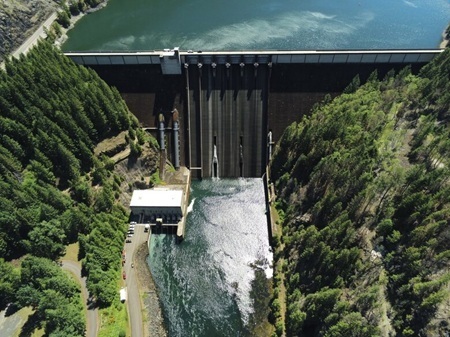The Water War Between Endangered Species and Human Necessity
The Detroit Dam rarely made the headlines until it threatened to leave the tap dry.
Behind the seemingly routine dam management plans lies a complex battle of priorities with real consequences. For the City of Stayton, Oregon, the battle centers around the Detroit Dam drawdown project, which could intentionally compromise their drinking water supply.
A Critical Water System Under Threat
Stayton draws its drinking water from the North Santiam River, downstream from Detroit Dam. The city's water treatment facility uses Slow Sand Filters that operate effectively only when water turbidity remains below 10 NTU (Nephelometric Turbidity Units). The project creates a vulnerability that few residents realize exists.
Stayton officials raised alarm bells when the U.S. Army Corps of Engineers proposed a deep-water drawdown at Detroit Lake to improve fish passage for endangered salmon and steelhead possibly. Similar projects have produced turbidity levels reaching 2,700 NTU, rendering treatment facilities ineffective. Killing the fishing process. Currently, a typical historical drawdown occurs yearly.
Federal environmental mandates that protect endangered fish species conflict with the fundamental human need for clean drinking water.
In addition, predation pressure, particularly from growing sea lion populations, represents another critical variable often underemphasized in policy discussions. These natural predators can significantly impact salmon runs, creating a predator-prey imbalance that officials have overlooked in declining Salmon populations.
Lessons
It is not merely a theoretical concern. In 2024, a similar drawdown at Green Peter Reservoir created a cautionary tale that Stayton officials are watching closely.
The resulting turbidity severely damaged Lebanon, Sweet Home, and Albany water treatment systems. These communities are now
pursuing legal action against the Army Corps of Engineers for $37 million in damages, highlighting the real-world consequences of well-intentioned environmental projects implemented without adequate consideration for downstream water users.
What happened there could easily happen to Stayton.
A Complex System With Multiple Purposes
Detroit Lake represents one of the Willamette River basin's most significant reservoirs, with a storage capacity of 455,100 acre-feet behind a 463-foot dam. Its management has many priorities, including flood control, power generation, navigation, recreation, irrigation, and fish passage.
Each purpose comes with regulations and advocates. Yet drinking water—perhaps the most fundamental human need—sometimes gets lost in the bureaucratic shuffle.
The technical complexity of dam management often obscures the human impact of these decisions.
Temporary Relief and Ongoing Concerns
For now, Stayton has received a reprieve. USACE has postponed the planned fall 2025 drawdown, acknowledging the legitimate concerns raised by affected communities.
This delay provides breathing room but does not provide resolution. The Army Corps does not expect to complete a supplemental environmental impact statement until early 2026, meaning the fundamental tension remains unresolved.
The postponement shifts the timeline of a potential crisis rather than eliminating it.
Proactive Response From Local Leadership
Stayton officials are not waiting passively for federal agencies to determine the future of their water. They have launched a multi-faceted approach to protect their community's interests:
1. Forming coalitions with other affected communities to amplify their collective voice.
2. Engaging legal experts to explore litigation.
3. Meeting directly with USACE representatives to explain their concerns.
4. Implementing enhanced water quality monitoring systems.
5. Exploring infrastructure upgrades and emergency supply alternatives.
These efforts reflect a reality: When the government imposes larger environmental policies, people often fight to protect their interests.
The Dilemma
Stayton's situation illuminates a broader challenge facing American infrastructure. How do we balance environmental restoration with the reliability of essential services? The aging dam and water treatment infrastructure throughout the country create vulnerabilities that become apparent only when stressed by management changes or natural events.
Everything downstream from major dams exists in a precarious relationship with federal agencies, whose mandates may not prioritize municipal water supplies. The tension between environmental goals and human necessities represents more than a first to third-world luxury. It also demonstrates a devaluing leap in policy that promotes a changing value, exalting the lives of animals and plants over the lives of humans.
Moving Forward With Informed Vigilance
For Stayton residents, the message is clear. Stay informed and engaged. The city continues to provide updates through council meetings and other communications, encouraging citizens to understand the potential impacts on their water supply.
The temporary postponement of the Detroit Dam drawdown provides valuable planning time but does not eliminate the conflict between fish passage and water quality.
Many ask whether federal agencies can develop approaches that truly balance these competing priorities without forcing impossible choices on communities like Stayton.
Stayton City officials have
begun a campaign to ask citizens to contact their state and federal congressional representatives with their concerns. The city's website has different samples of letters for interested parties.
The Corp. of Engineers also
requests comment until June 21, concerning the more destructive "Deep" drawdowns versus the historically done normal drawdown to support fish species traveling up and down the rivers. Here is the Email for the Corp. of Engineers for public comments: Willamette.EIS@usace.army.mil.
--Rob Taylor| Post Date: 2025-06-15 14:32:53 | Last Update: 2025-06-15 16:27:41 |






